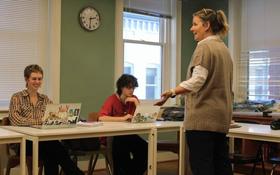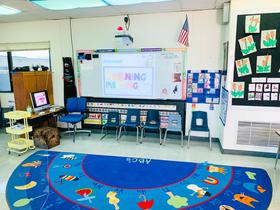For the 2025-26 school year, there are 6 public preschools serving 2,424 students in Palmer, AK.
The top ranked public preschools in Palmer, AK are Pioneer Peak Elementary School, Cottonwood Creek Elementary School and Butte Elementary School. Overall testing rank is based on a school's combined math and reading proficiency test score ranking.
Palmer, AK public preschools have an average math proficiency score of 48% (versus the Alaska public pre school average of 32%), and reading proficiency score of 35% (versus the 29% statewide average). Pre schools in Palmer have an average ranking of 8/10, which is in the top 30% of Alaska public pre schools.
Minority enrollment is 32% of the student body (majority Hispanic), which is less than the Alaska public preschool average of 57% (majority American Indian).
Best Public Preschools in Palmer, AK (2025-26)
School
(Math and Reading Proficiency)
(Math and Reading Proficiency)
Location
Quick Facts
Rank: #11.
Pioneer Peak Elementary School
(Math: 56% | Reading: 44%)
Rank:
Rank:
8/
Top 30%10
1959 N Stringfield Rd
Palmer, AK 99645
(907) 861-5700
Palmer, AK 99645
(907) 861-5700
Gr: PK-5 | 471 students Student-teacher ratio: 15:1 Minority enrollment: 31%
Rank: #22.
Cottonwood Creek Elementary School
(Math: 55% | Reading: 30-34%)
Rank:
Rank:
8/
Top 30%10
800 N Seward Meridian
Palmer, AK 99645
(907) 864-2100
Palmer, AK 99645
(907) 864-2100
Gr: PK-5 | 428 students Student-teacher ratio: 16:1 Minority enrollment: 32%
Rank: #33.
Butte Elementary School
(Math: 45-49% | Reading: 30-34%)
Rank:
Rank:
7/
Top 50%10
4006 S Butte Rd
Palmer, AK 99645
(907) 861-5200
Palmer, AK 99645
(907) 861-5200
Gr: PK-5 | 272 students Student-teacher ratio: 15:1 Minority enrollment: 31%
Rank: #44.
Colony Middle School
(Math: 43% | Reading: 34%)
Rank:
Rank:
7/
Top 50%10
9250 E Bogard Rd
Palmer, AK 99645
(907) 761-1500
Palmer, AK 99645
(907) 761-1500
Gr: PK-8 | 757 students Student-teacher ratio: 22:1 Minority enrollment: 29%
Rank: #55.
Valley Pathways
Alternative School
(Math: ≤20% | Reading: 20-29% )
Rank:
Rank:
5/
Bottom 50%10
1150 North France Rd
Palmer, AK 99645
(907) 761-4650
Palmer, AK 99645
(907) 761-4650
Gr: PK-12 | 153 students Student-teacher ratio: 13:1 Minority enrollment: 44%
Rank: n/an/a
507 N Gulkana
Palmer, AK 99645
(907) 861-5300
Palmer, AK 99645
(907) 861-5300
Gr: PK-2 | 343 students Student-teacher ratio: 15:1 Minority enrollment: 34%
Palmer, Alaska Public Schools (Closed)
School
Location
Quick Facts
Horizon Charter (Closed 2005)
Charter School
Po Box 3927
Palmer, AK 99645
(907) 745-4675
Palmer, AK 99645
(907) 745-4675
Gr: PK-12 | 158 students Student-teacher ratio: 79:1 Minority enrollment: 23%
Po Box 4897
Palmer, AK 99645
(907) 745-1486
Palmer, AK 99645
(907) 745-1486
Gr: 1-12 | 83 students Minority enrollment: 20%
Frequently Asked Questions
What are the top ranked public preschools in Palmer, AK?
The top ranked public preschools in Palmer, AK include Pioneer Peak Elementary School, Cottonwood Creek Elementary School and Butte Elementary School.
How many public preschools are located in Palmer?
6 public preschools are located in Palmer.
What is the racial composition of students in Palmer?
Palmer public preschools minority enrollment is 32% of the student body (majority Hispanic), which is less than the Alaska public preschools average of 57% (majority American Indian).
Which public preschools in Palmer are often viewed compared to one another?
Popular comparisons of public preschools in Palmer include: Swanson Elementary School vs. Pioneer Peak Elementary School
Recent Articles

Gifted & Talented Programs in Public Schools
Explore opportunities and controversies in gifted & talented programs鈥攅quity, outcomes, and models shaping public education in 2025.

Evaluating STEM in Public Schools: A Parent & District Guide
A guide to evaluating STEM programs in public school districts鈥攎etrics, best practices, equity, and 2025 trends for parents and community stakeholders.

Special Education in Public Schools: Understanding IEPs & Services
What parents need to know about IEPs, services, rights, and how to get the best support in public schools in 2025.
